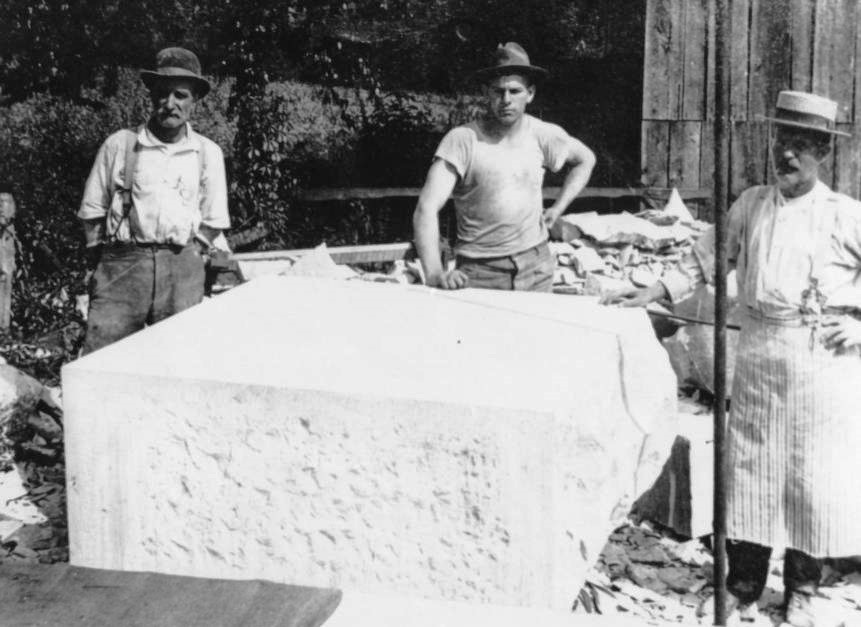Perhaps an oxymoron, but the history of the Concord/Farragut area would not be complete without documenting the fact that this area is known throughout the world for something that it is not! Yes, during the late nineteenth century, the community of Concord became widely known as the source of pink marble and was a key marble-transloading center for transferring the marble from boats to railway cars for transporting out of the area.
However, this decorative building stone, described as pink marble (and varying shades of gray), is rather a type of crystalline limestone and geologists will be quick to explain that the material is not true marble. But because it lends itself to the ease with which it can be polished, it is known throughout the world as “Tennessee marble.”

Woods Marble Quarry (Photo courtesy of Farragut Museum and Doris Woods Owens)
Through a more in-depth geologic study, this writer has learned that this stone occurs in belts of Ordovician-period rocks known as the Holston Formation and is quarried primarily in Knox, Blount, Loudon, Union and Hawkins counties. The Tennessee State Geological Survey identifies six primary Holston Formation belts, many of which are now names of area communities: Luttrell, Black Oak, Concord, Knoxville, Bays Mountain, and French Broad. A seventh belt, known as the Galbraith Belt in Hawkins County, is considered an extension of the Black Oak.
The Concord belt stretches from Sweetwater through Knox County to Strawberry Plains. By 1885, Concord was home to 10 marble-related companies. The most quarried was a mine that existed on Callaway Ridge, once operated by Republic Marble Company and later operated by James F. Woods Marble Company (Callaway Ridge is sandwiched between the shore of Fort Loudoun Lake and the Concord Road/Northshore Drive round-about).
Other marble companies that may be remembered are Forks of the River, Meade Quarry, Candoro Marble Works, Ross Marble Quarry, Gray Knox, Bond Quarry, Dunlap and Tennessee Marble Company. The successful businessmen that bought and sold these companies, either within the area or joined with other mining entrepreneurs, are a virtual who’s who and worth mentioning: William Patrick, George Ross and heirs, Frank Meade, John J. Craig and heirs, W.H. Evans, James Farmer Woods, Harmon Kreis, Thomas Deane and John Barksdale Jones.
In 1886, Hal Glaspy Winfrey, his brothers and other stonecutters made the move from Hawkins County to Concord because of the lure of more work and better education for their children. Winfrey’s brother, the Rev. William Winfrey, became the first minister of Concord Baptist, and the family business, Winfrey Brothers Stone Setting company, was formed. In 1961, the business sold to Georgia Marble Company.

James Farmer Woods Jr. (Photo courtesy of Farragut Museum and Doris Woods Owens)
This beautiful resource that gives “bragging rights” to the people from Concord/Farragut community are on display in many public buildings and monuments. Perhaps the earliest use of the marble for building was in the Ramsey House, constructed in 1797 by English architect Thomas Hope for Col. Francis Alexander Ramsey.
Other better-known examples that have Tennessee marble are the National Gallery of Art in Washington, D.C., Grand Central Terminal in New York, the Knoxville Post Office on Main Street and the Capitol Building in Nashville.
The First Amendment Tablet was initially on display at the Washington Newseum building in Washington, D.C., and in May 2022 was donated to the National Constitution Center in Philadelphia. Two of the best-known Tennessee marble sculptures are E.C. Potter’s lions, Patience and Fortitude, that stand outside the entrance to the New York Public Library Main Branch.
Thank you to Dr. Susan Knowles for her excellent research, author of Marble Industry of East Tennessee, 1850-1963 from which much of this information was gleaned.
Mona Isbell Smith is a retired computer systems analyst who enjoys freelancing




